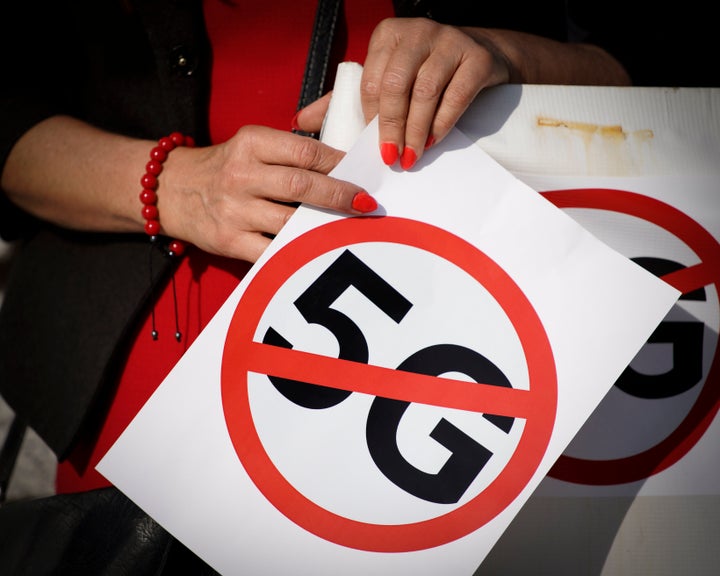Get the latest on coronavirus. Sign up to the Daily Brief for news, explainers, how-tos, opinion and more.
Conspiracy theories about 5G technology and coronavirus have been strongly condemned by the government after two phone masts were apparently set on fire at the end of this week.
At a press conference on Saturday, Cabinet Secretary Michael Gove labelled theories spreading on the internet as “dangerous nonsense”, whilst Stephen Powis, the medical director for NHS England called it “the worst kind of fake news”.
Video footage of a mast on fire in Sparkhill, Birmingham on Thursday evening was widely shared on Twitter, while the Liverpool Echo reported in the early hours of Saturday morning that a mast was also ablaze in Melling, Merseyside – hours after the city’s mayor Joe Anderson criticised the theories as “bizarre”.
It has not yet been confirmed that the fires were linked to false concerns about 5G technology and coronavirus, but the connection has been widely discussed online and the prominence of such theories has risen sharply in recent days.
West Midlands Fire Service told BBC news that the fire in Birmingham involved a 70ft tower on a telecommunications site, but said the cause was yet to be identified and it was not yet confirmed that the mast was in fact 5G.
A West Midlands Police spokesman said: “We’re aware of a fire involving a phone mast, but are awaiting further details on its cause.”
The Liverpool Echo reported that Merseyside Fire and Rescue confirmed crews had been in attendance at the incident, but the cause of the fire was not yet clear.
Trade body Mobile UK, which represents network providers, described the false theories – which link the introduction of 5G technology with outbreaks of coronavirus – as “concerning”, the BBC reported.
The Guardian reported on Friday that telecoms engineers had been subjected to verbal and physical threats. The fear of violence has even prompted BT Openreach engineers (who provide broadband, not mobile services) to post publicly in anti-5G Facebook groups, pleading with members to abstain from abusing them in the street.
Speaking on Saturday afternoon, Powis said: “The reality is that the mobile phone networks are absolutely critical to all of us, particularly in a time when we are asking people to stay at home and to not see relatives and friends.
“But in particular those are also the phone networks used by our emergency services and our health workers and I am absolutely outraged, absolutely disgusted, that people would be taking action against the very infrastructure that we need to respond to this health emergency.
“It is absolute, utter rubbish and I can’t condemn it in terms stronger than that.”
““We know that conspiracy theories are a way of coping with stressful or little–understood situations such as coronavirus, so it makes sense that the 5G conspiracy has come to the fore.”
- Dr Daniel Jolley
Concerns about 5G presenting a threat to public health predate the coronavirus crisis – as installation of infrastructure for the new service ramped up in 2019 numerous petitions to local authorities around the country were delivered, some with thousands of signatures.
But as Covid–19 continues to spread, it appears that an increasing number of people are looking to conspiracy theories such as 5G to explain the virus’ lethality.
Facebook groups – at least one of which has already been banned by the social network – have sprung up around the theory, and a now–deleted petition was widely circulated, including by celebrities such as Amanda Holden.
Dr Daniel Jolley, a chartered psychiatrist and senior psychology lecturer at Northumbria University, specialises in studying conspiracy theories.
“In a lot of cases it’s an example of confirmation bias,” he explained. “People are seeing something that reinforces their world view – if they already believe in a government conspiracy or something like that, and it helps to explain this really unprecedented situation, then you could see they would cling to these theories.
“We know that conspiracy theories are a way of coping with stressful or little–understood situations such as coronavirus, so it makes sense that the 5G conspiracy has come to the fore.
“There’s evidence that links a belief in conspiracy theories to hostility and violence, and while that’s mostly been linked to terrorist activity, it can also be seen in the current situation.”
Theories about 5G – and subsequent apparent attacks both on infrastructure and engineers – have now come to such a point that on Friday the government department for Digital, Culture, Media and Sport published a tweet stating that they were “aware of inaccurate information being shared online about 5G”.
It only takes a glance at the replies to the tweets to see that this information from the government can easily be passed off as lies by those invested in theories around 5G and government control.

When official accounts can’t dispel theories – and are even used as further fuel to propel the theory forward – there’s a clear challenge in tackling misinformation.
“We know that people are more likely to trust family and friends than they are their doctor, so one way we can tackle these theories is by simply talking with anyone in our immediate circle or in our networks who we see sharing conspiracy theories,” Jolley explained.
“It’s not likely to be an easy conversation – if it’s something that someone is really invested in you’re not going to win them round during that initial chat, but opening up that conversation is important.
“It’s also really important that we don’t share dodgy information accidentally – my advice before you share or retweet article would be to read it really thoroughly and evaluate whether or not you can trust the source.
“It’s a worrying but interesting time in this field of psychology – we’ve never been in a situation like this where there’s a pandemic and such a flow of constant information and instant access to media.
“Hopefully it won’t be in our lifetime, but in a future pandemic situation I imagine they’d look back and learn from what we all went through in order to inform the way information is distributed.”
